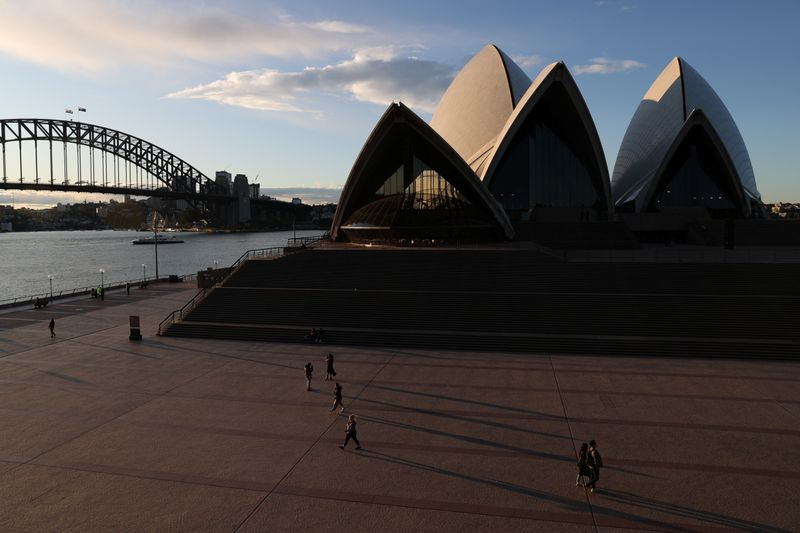Analysis: Shut off from the world, Australia fosters red-hot growth at home By Reuters

By Swati Pandey
SYDNEY (Reuters) – A year after the coronavirus pandemic pummelled Australia’s economy, IT contractor Ashok Ravindran has a nice problem: deciding which of three job offers to accept.
His happy dilemma is a reflection of an economy that is now larger than its pre-pandemic level. Exports are booming, consumer and business confidence are high and employment has beaten all expectations, with job vacancy rates at a 12 1/2 year high.
The Sydney resident only quit his last job two weeks ago.
“The market is really hot right now. I tried a few companies just to test waters and received three offers,” Ravindran told Reuters. “I got counter offers from each of them. That made it harder to say no as you don’t want to burn your bridges.”
Far from last year’s dire predictions, Australia’s unemployment rate has slid to a pre-pandemic level of 5.1%, home building approvals are at a record high and consumer spending is euphoric.
The A$2 trillion ($1.5 trillion) economy is now larger than before the once-in-a-century pandemic hit its shores. Sporting events are again a major spectacle and pubs overflow with patrons. In many states and territories, masks are an uncommon sight.
If anything, the very constraints that were expected to hurt demand, such as closed international borders and limited domestic mobility, have serendipitously channelled new sources of growth.
Instead of travelling to Bali or Bangkok, Australians are holidaying locally. Working from home requirements have prompted many to base themselves in new residences outside major cities, propping up demand in smaller towns. Physical distancing rules have spurred online retail sales while dining out has never been this popular.
“Australia is breaking records in what must be one of the fastest economic recoveries in modern history,” said AMP Capital Australian Equities Portfolio Manager Dermot Ryan.
“The economy is riding the wave of a triple boom in mining, housing and corporate profitability.”
While the country is in the midst of a worsening trade war with the world’s largest trading nation, China, Australia’s exports are miraculously booming, thanks to soaring prices of iron ore and newer markets in Asia and Middle East to sell to.
Economists expect this golden run to extend awhile.
Australia’s swift economic recovery from its first recession in three decades in 2020 has been driven by its ability to largely re-open from coronavirus lockdowns earlier than expected and solid monetary and fiscal stimulus.
The combination has triggered a property bull run, freeing up a huge amount of capital that was prudently held back by banks in 2020 in case of a COVID-induced housing crash.
AMP’s Ryan said both the mining and banking sectors have the potential to return over A$50 billion each to investors over the coming financial year.
The surge in home prices has sparked a building boom, sending shares of building products makers such as James Hardie and Brickworks to record highs. Shares of Australia’s top mortgage lender Commonwealth Bank, are at all-time highs after ceremoniously surpassing A$100 on May 28.
In another sign of solid business recovery, CBA this month said its financing of light commercial vehicles is up a startling 187% since January over the past year while loans for equipment and machinery jumped 21% in May, compared with the same time last year.
Consumers, too, are feeling confident with survey results consistently showing optimists far outnumber pessimists.
Indeed, retail sales have surged 25% on a year ago and vehicle sales have skyrocketed 68%. Household goods retailing has boomed, led by appliances and furniture as people renovate homes or build new houses.
Demand is so strong that home supplies and hardware chain Bunnings is now facing a timber shortage.
Companies are also facing a labour shortage with tens of thousands of Australian citizens still stuck overseas.
Their fate hangs in the air as Australia has pledged to keep borders shut well into next year, which also means skilled migration – which was propelling the economy until 2019 – is practically impossible.
The decision to keep borders closed is popular with the general public with recent state elections showing that leaders who take a hardline stance on COVID are heavily favoured.
Tight border controls, slower interstate migration together with solid business confidence and profitability have helped tighten the labour market, with some sectors such as IT, engineering, hospitality and healthcare facing severe shortages.
This has frustrated businesses who are calling for border restrictions to be eased.
“The current international border setting is virtually no-one-in and no-one-out,” said Innes Willox, chief executive of Australia’s employer association Ai Group.
“This needs to give way to a more sensible position and a much more ambitious border opening goal than the July 2022 target currently adopted by the Federal Government,” Willox added.
“Our critical skill shortages are only going to get worse the longer our border remains closed.”
For the likes of Ravindran, however, there has never been a better time to look for work. “I am confident my contract will be renewed when it comes up for renewal. There is enough demand right now.”
($1 = 1.3160 Australian dollars)

